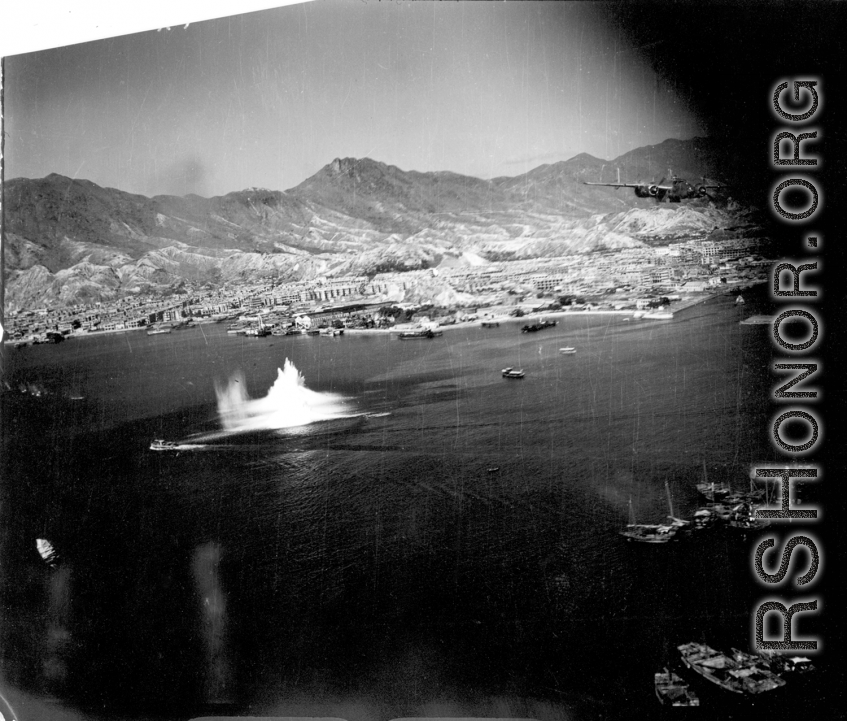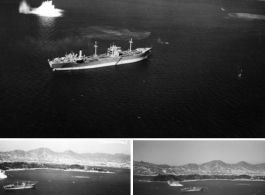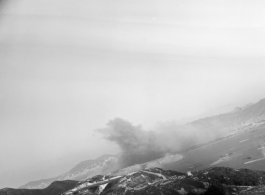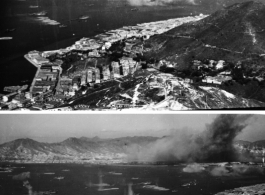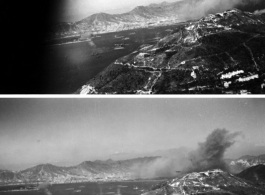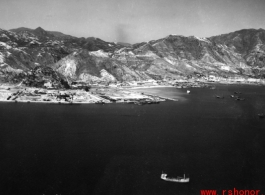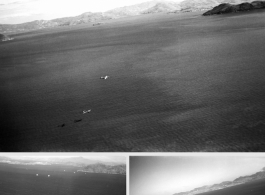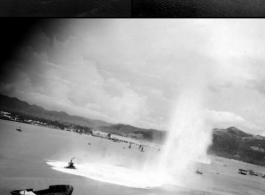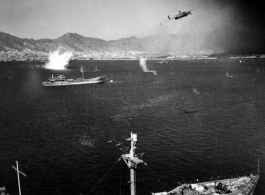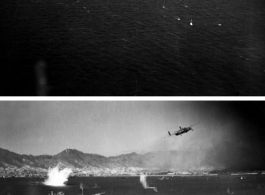Bomb explosion on a mission on Hong Kong, 491st Bomb Squadron.
Operation Report – Attack on Victoria Harbor, Hong Kong,
October 16, 1944
Extracted from "The Record – 11th Bomb Squadron"
Created by Squadron Personnel in 1945
October 16, 1944
Extracted from "The Record – 11th Bomb Squadron"
Created by Squadron Personnel in 1945
In effectiveness, operations for October showed not the slightest decline. One mission of that month---a low-level attack on shipping in Hong Kong harbor, is undoubtedly the most outstanding in the entire history of the Squadron, while ranking with our best from any period are at least ten other missions of October. Included among the latter are two high-level attacks upon the waterfront and storage area at Samshui, on the West River neat Canton. Perfect bomb patterns in both missions virtually destroyed this vital supply and staging depot. Also highly successful was a sustained series of night assault by large numbers of aircraft on the Tien Ho and White Cloud Airdromes at Canton. In a total of 7 missions of this kind, 53 of our planes struck at the revetments and runways of these fields. Reminiscent, moreover, of our earlier strikes against shipping was a successful sea sweep of October 26th, in which a B-24 equipped with sea-search radar led two of our planes to a large Japanese convoy in the South China Sea west of Hong Kong. In a single skip-bombing run over this heavily defended target, 1st Lt. Arthur F. Thomas destroyed one freighter of 350 feet and probably destroyed a 200 foot tanker.
In the midst of these effective operations from Liuchow, Capt. Theodore J. Michel, who had commanded the organization since April, was transferred to Headquarters, 341st Bombardment Group. The period of Capt. Michel's command of the unit had coincided with our greatest activity and accomplishment, and our success in this period was in large measure due to his excellent leadership. Command of the Squadron was assumed by Major Charles G. Willes, a graduate in 1941 of the Military Academy at West Point. Major Willes had served in China with our Group in the early part of 1944, and more recently had been assigned in India. Flying his first mission with the Eleventh on October 23rd. Major Willes thereafter led the Squadron in many difficult and well executed missions.
It is fitting indeed that one of the last missions flown by the Squadron in its long and bitter fight to defend Southeast China should be not only the greatest in the history of the unit but also perhaps the foremost single achievement of the 14th Air Force. This was the low-level attack of October 16th enemy shipping in Hong Kong harbor. The opportunity to strike this crippling blow at the Japanese merchant marine had been provided by the American Navy, whose task forces were then prowling in Formosa waters. Fleeing this menace, an enormous number of enemy ships of all types had sought refuge in Victoria Harbor at Hong Kong. A breakdown of this concentration of shipping by type and tonnage will be found in the official P. I. Report which is reproduced in the Appendix.
Our part in this historic operation can best be presented by the following quotation from the official mission report:
"Four B-25's of this squadron (11th) with four Mitchells of the 491st Bombardment Squadron (M) were briefed for a concerted low level attack on shipping at Victoria Harbor, Hong Kong. As briefed, this attack was to be made immediately after the high level bombing of the Kowloon docks by the B-24's, in order to confuse and disperse the AA defenses of the area. Close cover for the Mitchells was to be provided by eight P-40's of the 76th Fighter Squadron. Leader of the flight of Mitchells was Capt. Danforth Loring. Each of the B-25's was loaded with six 500 lb. GP demos with tail fusing set at 4-5 second delay.
"The B-25'5 took off from Liuchow at 10 :45 hours and, having rendezvoused with their escort and the formation of heavies, left the vicinity of the field at 12:31 hours for Waichow. Capt. Joseph P. Byrne was the lead navigator for the Mitchell formation. Reaching Waichow at an altitude of 0,000 ft., the Mitchells took up a heading of 215 degrees for Victoria Harbor, arranged themselves in line abreast formation, and commenced their dive. There were seven B-25's over the target. one aircraft of the 491st squadron having turned back because of engine trouble.
"Owing to the expert calculations of the lead navigator Capt. Byrne, the seven Mitchells hit the deck at the Kowloon waterfront and were able without changing course to sweep Victoria Harbor in line abreast formation. Still on a 215 degree heading, the right icing plane hit the waterfront slightly N of the Kowloon Wharves, Thus the Mitchells made a clean sweep of the entire section of the harbor lying S of Stonecutters Island and E as far as the Royal Navy Yard.
"The heavies bad bombed the Kowloon docks approximately two or three minutes before the Mitchells commenced their bomb run, and this area was already covered with a heavy pall of smoke and bomb dust. Though this interval was greater than had been planned. the heavy AA defenses were so well distracted that their fire at no time menaced the formation of Mitchells. The bursts of heavy caliber AA fire were widely scattered and several thousand feet above the mediums during their bomb run. However, an intense barrage of automatic weapons and machine gun fire was encountered from the enormous concentration of vessels in the harbor. Despite this hazard none of the Mitchells deviated from its assigned path across the harbor and all pressed home their attacks with extraordinary accuracy.
"The four aircraft of this squadron were the left wing element of the formation. As they came across the harbor at 75 to 100 ft. altitude, the nose guns of all planes were trained on targets in their path while top turret, waist and tail gunners strafed ships on either side. In the 45 second bomb run over 6,500 rounds of 50 cal. ammunition were expended in strafing attacks by the four B-25s’ of this squadron. Excellent photos were taken by Sgt. Arvid J. Johnson and T/Sgt. Robert F. Mongel who at the same time operated tail turrets in their respective planes. The heaviness and accuracy of the strafing undoubtedly caused destruction which could not he observed. and in any case reduced the effectiveness of the AA fire from the vessels. In one case pilot 1st Lt. Leander L. Smith, seeing the flashing of automatic weapons from a vessel slightly to the right of his path, kicked his rudder and with all nose guns firing sprayed the decks of this vessel from stem to stern and the firing was seen to cease.
'The plane on the right wing of our element, a B-25H ( No. 43-4272), was piloted by 1st Lt. L. L. Smith. Lt. Smith found three large vessels directly in his path and his bombardier¬-navigator, 1st Lt. Thomas S. Ackley, succeeded in toggling two bombs on each of these targets, The first of these vessels was a freighter or possible tanker of about 350 ft. in length. One of the bombs dropped on this target was a direct hit. The tail gunner and members of other crews observed a large secondary explosion on the boat after which a fire sprung up amidships. The other bomb dropped on this target may also have been a hit. Heavy black smoke was rising from this ship when it was last seen and red flames were visible on the deck. Lt. Smith’s second target was a freighter of about 300 ft, The first of Lt. Ackley’s bombs was a very near miss at the stern of this vessel while the second was over. Because of the proximity of the near miss this vessel is claimed as damaged although no fire or other results were observed. On the last target of Lt. Smith's plane, another freighter of about 300 ft., Lt. Ackley scored one short near miss which may have damaged the vessel while the second bomb was over by about 50 feet.
"On the left of Lt. L. L. Smith was Capt. Danforth Loring flying a B-25J (No. 43-4081) . In his lane Capt. Loring found a large freighter of over 400 ft. in length. This vessel had a well deck amidships, with prominent superstructure fore and aft. During a long run on this target Capt. Loring strafed continuously with his nose guns and numerous tracers were seen hitting the target. Passing over this freighter at an altitude of 75 ft., Capt. Loring trained out all his bombs at 20 ft. intervals. Two bombs were observed to be direct hits, four were near misses---two extremely close to the vessel on either side. An enormous secondary explosion on this boat was observed by Capt. Loring’s tail gunner and by members of other crews, and the boat immediately took fire and was smoking heavily, when last observed.
"Lt. Charles S. Nichols was flying a B-25J (No, 43-4091) on the left wing of Capt. Loring. His bombardier-navigator, 1st Lt. Jack Krug, also managed to toggle bombs on three targets in his path. He scored one direct hit with two bombs on a 350 ft. vessel. The other bomb toggled on this first target was over. Coming next upon a 200 ft. freighter, Lt. Nichols' bombardier scored a direct hit at the stern with one bomb. After the bomb explosion black smoke arose from the stern of this vessel and it appeared to be settling slightly at the stern. This vessel is claimed as probably destroyed. Lt. Nichols’ last target was a 400 ft. freighter on which Lt. Krug toggled his three remaining bombs. The vessel lay at right angles to the direction of the plane's approach. The first two bombs fell short, while the third struck the vessel at the water line and exploded directly along sine the boat close to the stern. A huge geyser of water and debris shot up to three times the height of the ship's mast. This vessel was clearly damaged.
"On the left wing of the entire formation was 1st Lt. Henry D. Wagner piloting a B-25J (No. 43-27807). Crowded over to the vicinity of the Kowloon Wharves and finding no targets in his path directly across the harbor, Lt. Wagner attempted to maneuver into position for an attack on the last vessel, a 400 ft. freighter, bombed by Lt. Charles S. Nichols. Passing over this target almost simultaneously with Lt. Nichols he trained al his bombs out at 20 ft. intervals. The entire string was over, the first bomb hitting approximately 50 ft. from the far side of the vessel.
"Claimed as destroyed are the 350 and 400 ft. freighters hit and left afire respectively by Lt. L. L. Smith and Capt. Danforth Loring. The 350 ft. merchant vessel and the 200 ft. merchant vessel on which direct hits were scored by Lt. Nichols are claimed as probably destroyed. The 400 ft. freighter on which Lt. Nichols scored one extremely close near miss, the bomb bursting at the water level alongside the ship, is claimed as damaged, as are also the two 300 ft. freighters on which near misses and one possible hit were scored by Lt. L. L. Smith.
"In the nature of things it is impossible to assess the damage caused by strafing or to credit the individual gunners. In several cases gun positions aboard vessels were seen to be silenced by strafing from some of the planes in the formation. Strafing attacks were made not only on vessels at anchor in the harbor, but also on boats tied up at the Kowloon Wharves and on buildings, docks, and gun installations along the Victoria waterfront. From the sheer weight of the strafing attack ( 6,558 rounds in 45 seconds) it can be safely assumed that heavy damage and perhaps casualties were caused.
"Two of our aircraft were sufficiently damaged by automatic weapons fire and machine gun fire from vessels in the harbor to necessitate major repairs. An explosive shell struck the left engine nacelle of plane No. 43-3884, piloted by Capt. Danforth Loring. Fragments of this shell penetrated several cylinders and caused unknown damage to the accessory section of this engine. Three machine gun bullets penetrated the bomb bay doors of Capt. Loring’s plane but caused no further damage. Plane No. 43-4272, piloted by 1st Lt. Leander L. Smith, was likewise hit in the left wing engine nacelle by an explosive shell which tore a ragged eight inch hole and caused a severe oil leak. Machine gun bullets penetrate the tail assembly and the nose of Lt. Smith’s plane without causing additional damage. Another explosive shell, probably 20 mm. caliber, struck and punctured the nose of Lt. Smith’s plane and penetrated the pilot’s compartment where it exploded. The force of the explosion blew out the window on the right side and glass fragments of this shell cut Lt. Smith’s chute to ribbons but he was uninjured. One other plane suffered damage. Plane no 43-27807, flown by 1st Lt. Henry D. Wagner, was struck by machine gun bullets which shattered the tail turret."
During the last weeks of our stay at Kweilin, the enemy offensive from the north had been coupled with a new drive from the Canton area which also had Kweilin and Liuchow for its objective. Both offensives had reached the approaches to Liuchow by the latter part of October, and we therefore stood ready to, on the last day of that month, to undertake our fourth and final evacuation.
Prepared by: Richard E. Voland,
Capt., Air Corps, S-2
11th Bomb Squadron
In the midst of these effective operations from Liuchow, Capt. Theodore J. Michel, who had commanded the organization since April, was transferred to Headquarters, 341st Bombardment Group. The period of Capt. Michel's command of the unit had coincided with our greatest activity and accomplishment, and our success in this period was in large measure due to his excellent leadership. Command of the Squadron was assumed by Major Charles G. Willes, a graduate in 1941 of the Military Academy at West Point. Major Willes had served in China with our Group in the early part of 1944, and more recently had been assigned in India. Flying his first mission with the Eleventh on October 23rd. Major Willes thereafter led the Squadron in many difficult and well executed missions.
It is fitting indeed that one of the last missions flown by the Squadron in its long and bitter fight to defend Southeast China should be not only the greatest in the history of the unit but also perhaps the foremost single achievement of the 14th Air Force. This was the low-level attack of October 16th enemy shipping in Hong Kong harbor. The opportunity to strike this crippling blow at the Japanese merchant marine had been provided by the American Navy, whose task forces were then prowling in Formosa waters. Fleeing this menace, an enormous number of enemy ships of all types had sought refuge in Victoria Harbor at Hong Kong. A breakdown of this concentration of shipping by type and tonnage will be found in the official P. I. Report which is reproduced in the Appendix.
Our part in this historic operation can best be presented by the following quotation from the official mission report:
"Four B-25's of this squadron (11th) with four Mitchells of the 491st Bombardment Squadron (M) were briefed for a concerted low level attack on shipping at Victoria Harbor, Hong Kong. As briefed, this attack was to be made immediately after the high level bombing of the Kowloon docks by the B-24's, in order to confuse and disperse the AA defenses of the area. Close cover for the Mitchells was to be provided by eight P-40's of the 76th Fighter Squadron. Leader of the flight of Mitchells was Capt. Danforth Loring. Each of the B-25's was loaded with six 500 lb. GP demos with tail fusing set at 4-5 second delay.
"The B-25'5 took off from Liuchow at 10 :45 hours and, having rendezvoused with their escort and the formation of heavies, left the vicinity of the field at 12:31 hours for Waichow. Capt. Joseph P. Byrne was the lead navigator for the Mitchell formation. Reaching Waichow at an altitude of 0,000 ft., the Mitchells took up a heading of 215 degrees for Victoria Harbor, arranged themselves in line abreast formation, and commenced their dive. There were seven B-25's over the target. one aircraft of the 491st squadron having turned back because of engine trouble.
"Owing to the expert calculations of the lead navigator Capt. Byrne, the seven Mitchells hit the deck at the Kowloon waterfront and were able without changing course to sweep Victoria Harbor in line abreast formation. Still on a 215 degree heading, the right icing plane hit the waterfront slightly N of the Kowloon Wharves, Thus the Mitchells made a clean sweep of the entire section of the harbor lying S of Stonecutters Island and E as far as the Royal Navy Yard.
"The heavies bad bombed the Kowloon docks approximately two or three minutes before the Mitchells commenced their bomb run, and this area was already covered with a heavy pall of smoke and bomb dust. Though this interval was greater than had been planned. the heavy AA defenses were so well distracted that their fire at no time menaced the formation of Mitchells. The bursts of heavy caliber AA fire were widely scattered and several thousand feet above the mediums during their bomb run. However, an intense barrage of automatic weapons and machine gun fire was encountered from the enormous concentration of vessels in the harbor. Despite this hazard none of the Mitchells deviated from its assigned path across the harbor and all pressed home their attacks with extraordinary accuracy.
"The four aircraft of this squadron were the left wing element of the formation. As they came across the harbor at 75 to 100 ft. altitude, the nose guns of all planes were trained on targets in their path while top turret, waist and tail gunners strafed ships on either side. In the 45 second bomb run over 6,500 rounds of 50 cal. ammunition were expended in strafing attacks by the four B-25s’ of this squadron. Excellent photos were taken by Sgt. Arvid J. Johnson and T/Sgt. Robert F. Mongel who at the same time operated tail turrets in their respective planes. The heaviness and accuracy of the strafing undoubtedly caused destruction which could not he observed. and in any case reduced the effectiveness of the AA fire from the vessels. In one case pilot 1st Lt. Leander L. Smith, seeing the flashing of automatic weapons from a vessel slightly to the right of his path, kicked his rudder and with all nose guns firing sprayed the decks of this vessel from stem to stern and the firing was seen to cease.
'The plane on the right wing of our element, a B-25H ( No. 43-4272), was piloted by 1st Lt. L. L. Smith. Lt. Smith found three large vessels directly in his path and his bombardier¬-navigator, 1st Lt. Thomas S. Ackley, succeeded in toggling two bombs on each of these targets, The first of these vessels was a freighter or possible tanker of about 350 ft. in length. One of the bombs dropped on this target was a direct hit. The tail gunner and members of other crews observed a large secondary explosion on the boat after which a fire sprung up amidships. The other bomb dropped on this target may also have been a hit. Heavy black smoke was rising from this ship when it was last seen and red flames were visible on the deck. Lt. Smith’s second target was a freighter of about 300 ft, The first of Lt. Ackley’s bombs was a very near miss at the stern of this vessel while the second was over. Because of the proximity of the near miss this vessel is claimed as damaged although no fire or other results were observed. On the last target of Lt. Smith's plane, another freighter of about 300 ft., Lt. Ackley scored one short near miss which may have damaged the vessel while the second bomb was over by about 50 feet.
"On the left of Lt. L. L. Smith was Capt. Danforth Loring flying a B-25J (No. 43-4081) . In his lane Capt. Loring found a large freighter of over 400 ft. in length. This vessel had a well deck amidships, with prominent superstructure fore and aft. During a long run on this target Capt. Loring strafed continuously with his nose guns and numerous tracers were seen hitting the target. Passing over this freighter at an altitude of 75 ft., Capt. Loring trained out all his bombs at 20 ft. intervals. Two bombs were observed to be direct hits, four were near misses---two extremely close to the vessel on either side. An enormous secondary explosion on this boat was observed by Capt. Loring’s tail gunner and by members of other crews, and the boat immediately took fire and was smoking heavily, when last observed.
"Lt. Charles S. Nichols was flying a B-25J (No, 43-4091) on the left wing of Capt. Loring. His bombardier-navigator, 1st Lt. Jack Krug, also managed to toggle bombs on three targets in his path. He scored one direct hit with two bombs on a 350 ft. vessel. The other bomb toggled on this first target was over. Coming next upon a 200 ft. freighter, Lt. Nichols' bombardier scored a direct hit at the stern with one bomb. After the bomb explosion black smoke arose from the stern of this vessel and it appeared to be settling slightly at the stern. This vessel is claimed as probably destroyed. Lt. Nichols’ last target was a 400 ft. freighter on which Lt. Krug toggled his three remaining bombs. The vessel lay at right angles to the direction of the plane's approach. The first two bombs fell short, while the third struck the vessel at the water line and exploded directly along sine the boat close to the stern. A huge geyser of water and debris shot up to three times the height of the ship's mast. This vessel was clearly damaged.
"On the left wing of the entire formation was 1st Lt. Henry D. Wagner piloting a B-25J (No. 43-27807). Crowded over to the vicinity of the Kowloon Wharves and finding no targets in his path directly across the harbor, Lt. Wagner attempted to maneuver into position for an attack on the last vessel, a 400 ft. freighter, bombed by Lt. Charles S. Nichols. Passing over this target almost simultaneously with Lt. Nichols he trained al his bombs out at 20 ft. intervals. The entire string was over, the first bomb hitting approximately 50 ft. from the far side of the vessel.
"Claimed as destroyed are the 350 and 400 ft. freighters hit and left afire respectively by Lt. L. L. Smith and Capt. Danforth Loring. The 350 ft. merchant vessel and the 200 ft. merchant vessel on which direct hits were scored by Lt. Nichols are claimed as probably destroyed. The 400 ft. freighter on which Lt. Nichols scored one extremely close near miss, the bomb bursting at the water level alongside the ship, is claimed as damaged, as are also the two 300 ft. freighters on which near misses and one possible hit were scored by Lt. L. L. Smith.
"In the nature of things it is impossible to assess the damage caused by strafing or to credit the individual gunners. In several cases gun positions aboard vessels were seen to be silenced by strafing from some of the planes in the formation. Strafing attacks were made not only on vessels at anchor in the harbor, but also on boats tied up at the Kowloon Wharves and on buildings, docks, and gun installations along the Victoria waterfront. From the sheer weight of the strafing attack ( 6,558 rounds in 45 seconds) it can be safely assumed that heavy damage and perhaps casualties were caused.
"Two of our aircraft were sufficiently damaged by automatic weapons fire and machine gun fire from vessels in the harbor to necessitate major repairs. An explosive shell struck the left engine nacelle of plane No. 43-3884, piloted by Capt. Danforth Loring. Fragments of this shell penetrated several cylinders and caused unknown damage to the accessory section of this engine. Three machine gun bullets penetrated the bomb bay doors of Capt. Loring’s plane but caused no further damage. Plane No. 43-4272, piloted by 1st Lt. Leander L. Smith, was likewise hit in the left wing engine nacelle by an explosive shell which tore a ragged eight inch hole and caused a severe oil leak. Machine gun bullets penetrate the tail assembly and the nose of Lt. Smith’s plane without causing additional damage. Another explosive shell, probably 20 mm. caliber, struck and punctured the nose of Lt. Smith’s plane and penetrated the pilot’s compartment where it exploded. The force of the explosion blew out the window on the right side and glass fragments of this shell cut Lt. Smith’s chute to ribbons but he was uninjured. One other plane suffered damage. Plane no 43-27807, flown by 1st Lt. Henry D. Wagner, was struck by machine gun bullets which shattered the tail turret."
During the last weeks of our stay at Kweilin, the enemy offensive from the north had been coupled with a new drive from the Canton area which also had Kweilin and Liuchow for its objective. Both offensives had reached the approaches to Liuchow by the latter part of October, and we therefore stood ready to, on the last day of that month, to undertake our fourth and final evacuation.
Prepared by: Richard E. Voland,
Capt., Air Corps, S-2
11th Bomb Squadron
